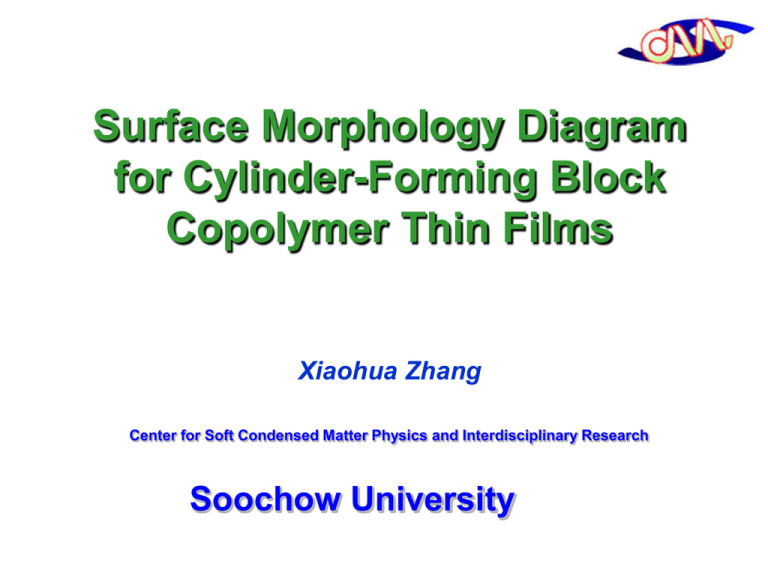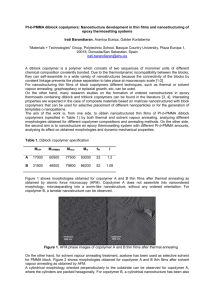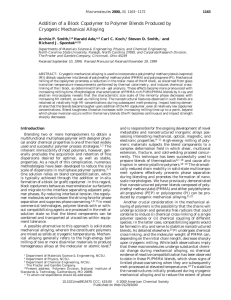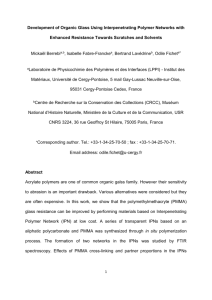3D Nanostructure
advertisement

Surface Morphology Diagram for Cylinder-Forming Block Copolymer Thin Films Xiaohua Zhang Center for Soft Condensed Matter Physics and Interdisciplinary Research Soochow University Background A B Phase diagram for a block copolymer with various structures Current Solutions Orientation of Cylinders • Needs - 3D nanostructure Manufacturing - 3D characterization of nanostructure - Control of 3D nanostructure • 200 nm Y. Gong et al Macromolecules 2006 39, 3369 200 nm T. Russell et al Adv. Mater. 2004 16, 226 T. Russell et al Langmuir, 2008, 24, 3545 Current Problems - 2D structures - Physical Template Self-assembling Materials for Bottom-up Nanofabrication Processes Challenges •Contain defects in many self assembled nanostructures. • Lack sufficient long-range order for certain nanotechnology applications. O2 RIE O2 RIE CF4 RIE CF4 RIE 35 nm period Hitachi Global Storage Technologies J. Cheng, Nature Materials, 3, 823-828(2004) Assembly of Block Copolymer Films Our goal: • Develop critical measurement solutions that enable nanomanufacturing with guided block copolymer assembly for next generation magnetic data storage, nanoscale electronics, and high efficiency membranes for energy. Method: •Combine unique modeling platforms with precision thermal processing techniques to enable the development of small angle x-ray and neutron scattering to measure structural uniformity, including orientation distributions, and pattern placement in self-assembled polymer films within templated surfaces. •Controlling Orientation using •Metrology of Orientation Cold Zone Annealing (CZA), sample in Nanostructured Films preparation procedure and unique thermal processing technique •3D Nanostructure for Cylinder-Forming Block Copolymer Thin Films SELECTIVE REMOVAL OF ONE OF THE BLOCKS RIE ETCH 3D Nanostructure Surface Morphology Diagram of PS-PMMA Block Copolymer Films on Oxide Silicon Substrate 180 160 200nm 7 Perpendicular 6 120 Mixed 100 5 4 80 Parallel hf / L0 hf / nm 140 Flow Coating 3 60 128 136 144 152 o 160 168 176 2 184 Spin Coating T/ C Materials: Poly (styrene-block-methyl methacrylate) Mn: PS(35500)-PMMA(12200) Mw/Mn: 1.04 C. M Stafford et al. Rev. Sci. Instr. 11(2006) 023908-1 Flow Coating without Residual Solvent Sample Preparation Procedure Dependence 200nm Spin-coated in air Flow-coated in air Spin-coated in toluene vapor Spin-coated in toluene vapor & prebaked prior to annealing Film thickness: 120 nm Annealing: 155˚C for 15 h Prebaking: 93 ˚C for 15 h Surface Morphology Diagram 200 8.0 180 7.2 6.4 140 5.6 120 4.8 100 4.0 80 3.2 60 2.4 128 136 144 152 o T/ C 160 168 hf / L0 hf / nm 160 200nm 58nm 71nm 86nm 104nm 130nm 168nm s Increasing Film Thickness PMMA PS AFM phase images of flow coated PS-b-PMMA block copolymers after annealing at 147 ˚C for 15 h. 3D Characterization of Nanostructure by Neutron Reflectivity (NR) NCNR in NIST qx Incident neutrons ki θ q Detector qz ko 2 ko θ ki q ki θ Sample ko 2 θ 2θ 2 ki q ko ki 10 0.000007 Air 0.000006 Si 0.000005 SLD 1 0.1 0.000004 0.000003 0.000002 0.000001 0.000000 0.01 0 200 400 600 800 Z(Å) 0.001 200nm 0.0001 0.00001 0 0.01 0.02 0.03 0.04 dPS-b-PMMA, 80 nm, 147 oC for 15 h 0.05 0.06 Orientation Distribution Measurement of 3D Nanostructure by RSANS We convert from beam-coordinates (qx,qy,qz) to sample-coordinates (Qx,Qy,Qz) using a rotation matrix Qx q x cos q z sin Qy q y Qz q x sin q z cos Qz Qy Qx Samples show a mix of parallel and perpendicular cylinder scattering Low-q scattering from size disorder Hexagonal pattern from laying-down cylinders Weak ring from random component Scattering peak from standing-up cylinders 200nm Film thickness:136nm Annealing:147ºC for 15h Content of perpendicular cylinders:80% Film thickness:141nm Annealing:165ºC for 15h Content of perpendicular cylinders:59% Data was fit by extending the model of Ruland and Smarsly. Ruland, W.; Smarsly, B. J. Appl. Cryst. 2005, 38, 78-86. Self-assembly Driving Force of 3D Nanostructure NR Measurements on Residual Solvent in PS-b-PMMA Films 10 -2 -3 16% Residual Solvent 0.3 0.2 0.1 0.0 10 -4 10 -5 -6 10 0.00 Si Air 300 600 900 Z(Å) Flow-Coated Film 0.03 0.06 0 10 -1 10 -2 10 -3 10 -4 10 -5 -6 0.09 0.12 0.15 10 0.00 Volume Fraction 10 -1 Reflectivity Reflectivity 10 Volume Fraction 10 10 0 12% Residual Solvent Air Si 0.3 0.2 0.1 0.0 0 300 600 Z(Å) 900 Spin-coated Film 0.03 0.06 0.09 -1 q(Å ) -1 q(Å ) PS-b-PMMA in deuterated toluene 0.12 PS Film Thickness and Molecular Weight Dependence 1.60 2 100 1.55 0.008 0.010 0.012 -1 q(Å ) 0.014 0.016 41 nm 0.01 91 nm 1E-4 208 nm 0.02 0.04 0.06 0.08 0.10 0.12 0.14 1.45 147 nm -2 0 50 100 150 200 250 d (nm) 1.40 1.30 0.16 0 400 800 1200 1600 2000 Z(Å) -1 2 1000 Reflectivity 100 10 1 1 (vol%) 1 Reflectivity -1 208 nm q(Å ) 100 0 1.35 147 nm 1E-6 0.00 41 nm 91 nm (vol%) -2 0.006 1.50 -6 Reflectivity 0.01 1 1 1 SLD 10 ,(Å ) Reflectivity 100 0.1 0.006 0.008 0.010 0.012 -1 q(Å ) 24 kg/mol 0.01 51 kg/mol 97 kg/mol 0 -1 1E-4 818 kg/mol 1E-6 0.00 0.02 0.04 0.06 0.08 -1 q(Å ) 0.10 0.12 0.14 -2 0 200 400 600 -1 Mn(kg mol ) 800 1000 0.01 0.01 0.006 0.008 0.010 0.012 -2 0.1 0.004 1.14 -6 Reflectivity 1 1E-3 As Cast One-step Two-step 1.16 10 1.12 SLD 10 ,(Å ) Reflectivity 1 1.18 As Cast One-step Two-step 100 100 0.014 -1 q(Å ) 1E-4 1.8 1.5 (vol%) PMMA Films 1.2 0.9 0.6 0.3 0.0 One-step As Cast Two-step Thermal History 1.10 1.08 1.06 1.04 1E-6 0.00 0.02 0.04 0.06 0.08 0.10 0.12 0 0.14 200 400 600 800 1000 1200 Z(Å) -1 q(Å ) NR data (symbols) of as-cast, one-step (93 oC for 15 h) and two-step (93 oC for 15 h followed by 155 oC for another 15 h) annealed PMMA films with as-cast film thickness of 121 nm at fixed molecular weight (20 kg/mol). 4.0 Reflectivity 1 100 3.5 1 3.0 0.01 0.006 0.008 0.010 0.012 -1 q(Å ) 0.014 0.016 69 nm 0.01 (vol%) Reflectivity 100 2.5 2.0 1.5 121 nm 1E-4 1.0 169 nm 0.5 1E-6 0.00 201 nm 0.02 0.04 0.06 0.08 0.10 0.12 0.14 0.16 0.0 60 90 120 150 180 210 -1 q(Å ) d (nm) NR scans (symbols) measured from the PMMA films of different thickness at fixed molecular weight (20 kg/mol). FTIR Characterization of Residual Solvent in BCP Films 0.0018 0.0016 Absorbance 0.0014 0.0012 0.0010 Toluene-d8 Peak 0.0008 0.0006 As-cast PMMA Annealed PMMA 0.0004 Annealed PS 0.0002 Macromolecules 2010, 43, 1117–1123. ACS Nano, 2008, 2, 2331-2341. As-cast PS PS (51kg/mol) PMMA (20kg/mol) Film thickness : 160 nm. 0.0000 2360 2340 2320 2300 2280 2260 2240 2220 2200 -1 Wavenumbers(cm ) Samples PMMA as cast film from 3% d-Toluene solution Residual solvent concentration (weight) 1.2 ± 0.2 % PMMA baked and dried in vacuum oven (repeat) < 0.2% PS as cast from 3% d-Toluene solution (repeat) < 0.4% PS baked and dried in vacuum oven < 0.4% The estimation of residual d-toluene concentration is based on its characteristic peak located around 2274 cm-1. Calibration is made with the area ratio of the strong bands corresponding to d-toluene (2274 cm-1) and PMMA (1730 cm-1) in the FTIR spectra of 3% polymer solution. Summary • Film preparation procedure, and other processing effects, cannot be ignored in nanomanufacturing applications. • Fundamentally demonstrate the interplay between intrinsic BCP structure and processing conditions. • R-SANS and NR can deduce orientational distribution in BCP cylinder thin films.











